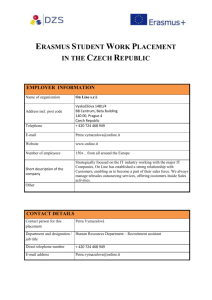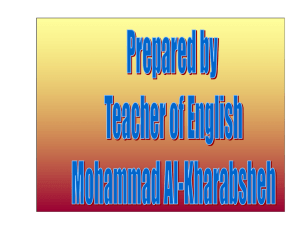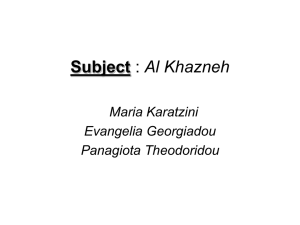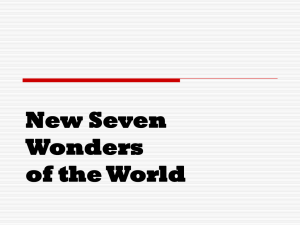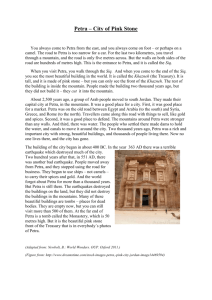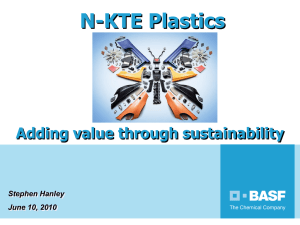PCU-CAMEL - Faculty e-Portfolio
advertisement
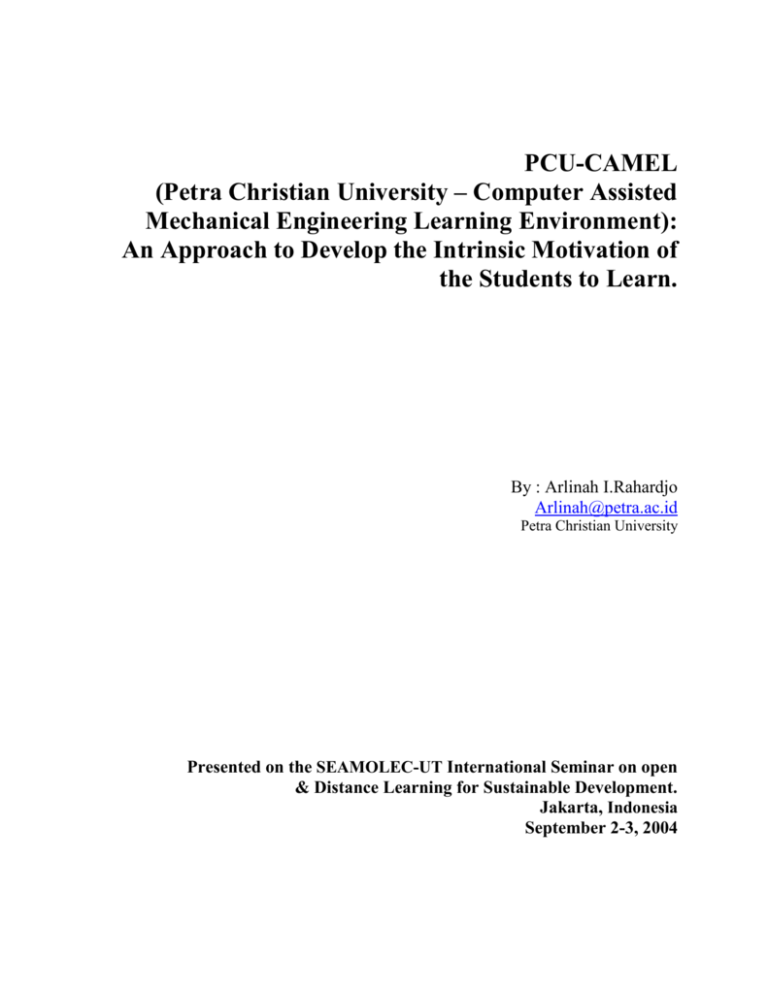
PCU-CAMEL (Petra Christian University – Computer Assisted Mechanical Engineering Learning Environment): An Approach to Develop the Intrinsic Motivation of the Students to Learn. By : Arlinah I.Rahardjo Arlinah@petra.ac.id Petra Christian University Presented on the SEAMOLEC-UT International Seminar on open & Distance Learning for Sustainable Development. Jakarta, Indonesia September 2-3, 2004 ABSTRACT In line with the five strategic plan of Petra Christian University, focusing on the issues of Caring, Globalization, IT-based campus, Excellence, Efficiency and Effectiveness, the Mechanical Engineering Study Program of Petra Christian University has decided to integrate the use of internet into the traditional, face to face setting of learning process in class. Developing A Webbased learning environment has become a consideration to house the class materials as well as to conduct online learning activities to go hand-in-hand with the traditional class activities. Some general characteristics of a web-based learning, such as access to learning resources and guest lecturers, two-way communication between students and their instructor, online discussion and collaboration among students even across campuses domestically and internationally, as well as online exercises and tests are some features designed into the online environment. Those features are designed to provide the students with more flexible, relatively easy and wider access to learning process and experiences in terms of space, time and global perspectives. SCORM conformed course material standardization is also used to give rooms for imported, shareable and re-useable course materials. User Registration, course management as well as grade-books are among those features designed for administrative and management purposes. A personalized and customized space for each instructor and student is highlighted in this learning environment to allow flexibility and personalization. This customization allows the instructors to develop flexible instructional designs for their courses. It also allows the students to integrate the intra and extra-curricular activities as well as to choose preferred way of knowledge gathering and sharing. The personalized space includes an exposure to the profiles of instructors and students within each course, with links to their individual portfolios. Those exposures allow them to get to know more of each other such as the teaching philosophy, learning styles, dreams, experiences, achievements etc. Together with spaces for online group discussion and collaborative works, this personalized space is specifically designed to develop a student-centered learning environment as a manifestation of CARE as the main focus of Petra Christian University Strategic Plan. It is also designed to support the onsite face to face learning mode with its emphasis on the human aspect such as unmediated presence of role models, affection and feelings to keep that spirit of CARE. This integrated mode of learning implemented in PCU-CAMEL serves as an effort toward the improvement of teaching and learning process at the Mechanical Engineering Study Program of Petra Christian University. By providing various approaches of learning in a student-centered learning environment, PCU-CAMEL is expected to enrich the learning experiences and develop more intrinsic motivation of the students as one of the key success to learn. Discussion of problems on e-learning practices in different forms conducted in some other Study Programs will also be addressed to serve as lessons learned in developing PCU-CAMEL BACKGROUND CONCEPT Learning Models and students’ motivation to learn are two inter-related factors, among others, to be said as giving impacts on promoting effective learning (McGregor, 1999). These two factors will be discussed further as an underlying design concept of Petra Christian University-Computer Aided Mechanical Engineering Learning Environment. In general, the learning model practiced in Indonesian educational system is mostly still based on the theory of behaviorism. This theory has given a more active role to instructors rather than to students. Instructors are giving lectures most of the time, while students are listening, taking notes and memorizing. This teacher-centered learning model, which gives emphasis in transferring knowledge, is still widely practiced even up to higher education institutions in Indonesia. The knowledge being transferred is very limited and can become quickly expired as the students enter the working world. This kind of learning model is believed not to give enough opportunities for students to express themselves, explore and solve problems independently as well as develop attitudes and competencies in acquiring and learning new knowledge. In this current fast changing society, those above attitudes are very much needed to stay alert to face changes and challenges. Then education is not enough if it is directed just to transfer knowledge as practiced in a teacher-centered oriented learning model. The world of education is more expected to build the foundation to develop self-confidence and abilities of the students to manage their own educational process and develop it as life-long activities Furthermore, by focusing on one style of teaching method, such as lecturing only, students are not so much exposed to other types of learning methods. Then the learning style of each individual student has not been touched and been developed further. This situation has left students with low motivation to love learning. Thus the Indonesian educational system actually needs a learning model that promotes intrinsic motivation of students to love learning and be life-long learners. A student-centered learning model is the current issue addressed to answer the challenge to promote intrinsic motivation and to develop life-long learners. It shows active roles of both instructors and students through interactivity and negotiation process in constructing new knowledge. This model also puts more emphasis on students as unique subjects instead of objects in the learning process. Each learner does not have to depend on the educators as the only information resources. They are expected to be responsible for their own learning, be able to work independently as well as collaboratively with other learners, find and make use of any learning resources and environments available. In a teacher-centered learning model, motivational programs mostly provide extrinsic rewards. This kind of extrinsic motivation was seen by some researchers as attempts to manipulate and control behavior instead of promoting a deeper learning. While intrinsic motivation to learn will be developed in a student-centered learning environment that helps students to discover for themselves why learning is important, stimulates curiosity and challenges, allows self-direction and choice and builds on prior knowledge to help students make links to what they have known (McGregor, 1999). Cole described the elements to develop intrinsic motivation to learn are clear vision and purpose of what students are learning for; control their own choice; cooperation or team-work and support from the entire community, the educators, friends, administrative staff, family; and challenges to create enthusiasm (Cole, 1997). Internet, which has communication capability, multimedia attractions, richness of information resources as well as the capability to surpass time and space, can become an alternative media to support the development of the life-long learning system. With those capabilities, the use of Internet in educational world will be able to accelerate the development of educational process, which do not put emphasis on the transfer of knowledge only but is able to develop intrinsic motivation of the students to learn. The learning process patterns are now possible to be directed towards providing the various opportunities of learning with open choices to meet individual interest, talent, speed, space and time. This way, it is expected that the intrinsic motivation for learning can continuously be mined. PCU STRATEGIC PLANS AND THE LEARNING MODEL ADOPTED Based on its Vision and Mission and SWOT analysis, Petra Christian University has developed a 5 years Strategic Planning 1999/2000 - 20004/2005 with its 5 focus: Caring, Excellence, Global, IT-based, Efficiency and effectiveness. This strategic Plan has been designed as a guideline for each unit in the university to plan their programs. A web-based learning built around the concept of a student-centered learning becomes an alternative to enrich the teaching-learning process at Petra Christian University and thus to develop the intrinsic motivation of the students to life-long learners. Though efficiency issues and outreach programs are also some of the concerns of Petra Christian University, the main goal of the university in using information technology is to improve better quality of instruction. By taking into considerations, the advantages of both onsite learning as well as online learning environments, Petra Christian University is not thinking of replacing the traditional onsite learning environment with online learning environment. With its five focus of strategic planning as reference, Petra Christian University is exploring the possibility of integrating the two models of learning environments into an Integrated Learning Environment that covers the two models. Each type of learning environment will complement and enrich the other type of learning environment and thus will also address different types of learning styles of the students. Onsite learning in traditional class meetings, with its emphasis on the human aspect such as unmediated presence of role model, affection and feelings, which characterize the issue of "Caring", will still be maintained at PCU, though this caring attitude can also be transmitted through careful design and practice of an online environment. This onsite environment will also be enriched by the use of online learning to give wider and flexible access to learning resources, which addresses the issues of "Global" and IT-based Campus". Thus this proposed integrated learning environment is expected to prepare PCU graduates to be life-long learners who qualify to the International standard of quality as well. By putting emphasis on the issue of "Caring", a student-centered learning model is a better choice to be applied in this PCU proposed integrated learning environment. Applying a teacher- centered learning model, in a technological environment with its "physical barrier" and "lack of human touch” will cause more distance relationship between students and instructors as well as passivity among the students. PCU PRELIMINARY INITIATIVES EFFORTS ON WEB-BASED LEARNING The issue of using Internet in enhancing the teaching-learning process has actually been addressed at Petra Christian University several years before. Some efforts and programs in exploring Internet as a potential media for teaching have been conducted, though as separate systems. Some web-Based programs have also been developed to eventually constitute the elements necessary to support the campus-wide proposed web-based integrated learning environment. Decided to give easy and up-to-date information on their status as students, The Student Administrative Office has developed ASIT (Student Academic Record System) since 1997. The Computer Center has also been developing the system into a web-based system that can be accessed at http://genesis.petra.ac.id/asit/. Through this system, the students can view their own records on courses they have participated, grades as well as financial status. Focusing on the issue of Caring as one of the university Strategic Plans, an electronic student portfolio has been developed in 2001 by The Student Affairs Office to allow students to record the history of their learning process as well as to motivate students to love learning by knowing themselves better. With this design in mind, the students are encouraged to plan their career ahead, to find and develop their own talents and competencies by assessing their own learning process and building self-confidence through their efforts and accomplishments. This project is also designed to be a media of communication between students and instructors, to let the instructors get to know each student better as a unique individual. The ESP can be accessed at http://genesis.petra.ac.id/portfolio Meanwhile, another similar tool has also been developed for the faculty members in the year of 2003, in the form of Electronic Faculty Portfolio. Each faculty member has been encouraged to record their own history of career, efforts as well as accomplishments in the area of teaching, research as well as community services. Through this media, they are encouraged to develop themselves to their full capacity through self-evaluation and reflection on their roles as a faculty member. The students are also able to get to know the faculty members better by accessing their records from http://fportfolio.petra.ac.id. The University library has also been striving to better serve the campus community by providing limitless access to PCU Library services and materials through Spektra (Petra Christian University Integrated Library System). This library system has been continuously developed since 1991 and can be accessed at http://dewey.petra.ac.id . Some digital library collection has also been integrated into Spektra in 2001. InCU-VL (a resource sharing program among Christian university libraries in Indonesia), accessed at http://incuvl.petra.ac.id has also been developed in1997 to offer even wider access of information resources to campus users. Besides those programs, which will be important elements to support an integrated approach of a web-based learning environment, some efforts have also been conducted to experiment the use of Internet in learning. There have been various types of internet-based learning efforts ranging from the very basic as just using emails and mailing lists to communicate to students, uploading the course materials on the web, collaborated projects with other students from some other international universities up to making available lesson plans, assignments and expecting students to upload their assignments on the class website. Some faculty members on individual basis have developed those efforts. A web-based program called YES (Young Excellent and Smart) was also developed in 2001. This program was designed as an orientation program for new entrants-candidates and could be accessed at http://yes.petra.ac.id . This media allowed the high school students who had been admitted to enter the university to get to know what they would be studying through communication with their future instructors as well as other new entrants-candidates. Information on each Study Program was provided regularly to allow students to get to know each program better. All of those programs have been made available to the campus members through PetraNet, a campus-wide network that has also been linked to Internet. An official campus website, http://www.petra.ac.id has also been set up to link all of the above programs. Each campus member is entitled to a free email account to get maximum access to those web-based programs. PCU-CAMEL: a student-centered based learning environment In line with the strategic plan of Petra Christian University, focusing on the issue of Globalization and It-based campus, Mechanical Engineering Study Program of Petra Christian University (PCU-MESP) has decided to integrate the use of Internet into the traditional, face to face setting of learning process in class. Developing A Web-based learning environment has become a consideration to house the class materials as well as to conduct online learning activities to supplement the traditional class activities. This integrated method of learning has been designed as an effort toward the improvement of teaching and learning process. By providing various approaches of learning to enrich the learning experiences of the students, the MESP expect more intrinsic motivation of the students to learn, will be developed. The web-based learning environment will also provide students with wider and flexible access to learning process and materials in terms of space and time. It will also anticipate the plans and any preparation of the MESP on sharing class materials with other universities as well as on implementing International Programs or Joint Programs with international partners. By then the efficiency and productivity of the Study Program will be achieved as the drop-out rates and the length of study of the students are reduced Funded by TPSDP (Technological and Professional Skills Development Project) grant, this environment has been decided to be called PCU-CAMEL (Petra Christian University Computer Aided Mechanical Engineering Learning Environment) and can be accessed at http://pcucamel.petra.ac.id. A project team has been set up consisting of Mechanical Engineering faculty members in developing the course materials, resource persons on pedagogy and Information Technology as well as students from Informatics Study Program who has and will develop this project as their final projects. The team has also defined the technical specification for the software developed, complying with the specification of the university general policy on the use of information technology as this prototype will also eventually be adopted by Petra Christian University as a part of campus-wide strategic plans. The grand project will eventually cover the integration of the web-based class materials and activities with the whole resources and activities outside classes, such as student information services, student extra-curricular activities, libraries, computer services, collaboration across Study Programs and across universities domestically as well as international. The whole project for 3 years was started in the year of 2002 and is expected to complete in the year of 2004. Designed and built with a student-centered learning concept and 5 elements of intrinsic motivation (vision, purpose, cooperation, support, control, challenge) in mind, this learning environment is planned to be finished in three phases. The first phase of PCU-CAMEL was developed around some general features of a web-based learning environment limited to class activities such as Instructor Information, Course Information, Lesson Plans, class materials, assignments, class calendar activities and news as well as class communication tools such as web-mail, mailing list and chat. During the second phase of the project, the features on class activities developed during the first phase of the project are enhanced with more flexibility and personalization on designing lesson plans, using the learning tools, uploading class materials as well as selecting preferred colors for the site. More features are also added such as the availability of Grade-books, Assignment Collectors, Project List, Online Exercises and Tests, Private Messages to any member of the class as well as Online Discussion, and Collaborative spaces for group projects among students even across campuses domestically and internationally. Learner Expectation and Class Reflection are two features to exercise reflective self-evaluation capabilities of the students as characterized in a student centered learning model. SCORM conformed course material standardization is also used to give rooms for imported, shareable and re-useable materials from guest lecturers or from future collaborative teaching with other institutions. All of those features, assigned in the course area can be customized. This customization allows the instructors to develop flexible instructional designs for their courses. In this course area, the learning environment has also accommodating different roles for each user depending on the permission granted by the administrator. Each user can be an instructor as well as a student at the same time. The instructor has also the permission to register students as well as guest lecturers by themselves. A customized space for each instructor and student is highlighted in this second phase of the learning environment to allow flexibility and personalization. This customization allows both instructors and the students to integrate the intra with the extra-curricular activities and gives flexible opportunities for them to choose preferred way of knowledge gathering and sharing. This concept of customization is very much reflected in the User Area with some features such as Personal File storage and sharing, Favorite Links, Schedule of class activities integrated with personal extra curricular activities, Diary, Reminder, Feedback Form and types of News they would like to subscribe. The personalized space also includes an exposure to the profiles of instructors and students within each course, through links to their individual portfolios. Those exposures allow them to get to know more of each other such as the teaching philosophy, learning styles, dreams, experiences, achievements etc. These flexibility, customization and collaborative capability features have been designed to reflect a student-centered learning environment. They also support the opportunities for the students to control their own learning experiences in acquiring and sharing resources. The Links to the Student and Faculty Portfolio, Features on Learner Expectation, Class Reflection as well as course information with its goals and activities as described in the Lesson Plan, are designed to help students get a clear vision on what they are going to learn in each semester as well as to discover and develop their individual learning goals even future careers. The Features on collaborative space for group projects, online discussion and file sharing are addressing the element of cooperation as well as support from instructors as well as other members of the class. Different approach of learning with relatively various accesses to learning resources and activities in term of space and time is a challenge in itself expected to arouse curiosity. It is hoped this approach of learning will develop the intrinsic motivation of the students to learn and become life-long learners. PCU-CAMEL IMPLEMENTATION: DISCUSSION AND PROBLEMS Two MESP faculty members were implementing their courses using the first phase project of this online learning environment on the second semester of 2003/2004, though not in its fully capacity. Based on their experiences, they were only successful in developing lesson plans, housing the class presentations on the PCU-CAMEL and telling the students to download the materials by themselves. The second phase project of PCU-CAMEL, which is still in its beta version, actually has just started to be implemented by some faculty members of MESP this first semester of 2004/2005. So there will not be many lessons or problems to share. However some similar web-based learning environment conducted by the author in the class of “System Analysis and Design” (SAD) of the Accountancy Study Program and the class of “Library Information System” (LIS) of the Informatics Study Program will be discussed as comparisons to justify the design concept of building PCU-CAMEL and anticipate challenges in its implementation. Some problems such as learning cultures, infrastructure and digital divide need to be given further thoughts. As discussed earlier, the teaching-learning process in Indonesia more or less is still concentrating on a teacher-centered model. Both instructors and students are still used to lecturing, memorizing and grades, regarded as extrinsic motivation. The student-centered learning models as imposed in PCU-CAMEL bewildered both instructors and students. The instructors still needed time and competencies to design various student-centered learning activities as well as to exercise being facilitators and motivators instead of transferring knowledge. While, most students, who were used to be passive listeners, were also found to be quite reluctant to be independent learners in trying to find learning resources beyond the lecture notes and textbooks assigned by the instructors, or to express their ideas in class as well as online discussion However there have been quite differences between the SAD and LIS students on the use of class website and class mailing list for discussion. The students of SAD only submitted 2 postings on average, out of 4 required postings in one semester. They had no positive responses on the use of class web site as well as mailing list, though some reasons were due to the accessibility to the Internet connection. They preferred class discussion rather than online discussion or visiting the class website from time to time. The students of LIS, who were more used to using Internet as a means of communication and got more access to computers in their computer laboratory, submitted 12 out of 16 required postings on average. 7 out of 23 students were even posting more than required. 15 students out of 23 students posted more than half of the required postings as they found out that they learned more by the extended discussion. Despite the different responses, all students from both programs declared that they gained benefits to have their assignments and works published on the class website as they can learn from each other. As noted in some responses on the use of mailing list and class website, most students complained on the campus minimum infrastructure. The limited number of computers available in campus was not enough to accommodate the needs for fairly use of the computers for all students. Personal computers as well as telephone rates for Internet connection from home are still a luxury for instructors and students. Then the third problem on digital divide had to be faced. Only instructors who had personal computers at home or at their offices as well as students, who could afford having their own personal computers at home or visiting Internet cafes, could have privileges to experience this online learning environment. There are still many students who could not afford getting accesses to Internet. Despite those problems, in general the students participated in those two above courses gave positive responses to this integrated learning environment. The responses were given via individual emails, class mailing lists as well as class reflection evaluation conducted at the last day of class. The SAD class, specifically designed to use this new environment due to its unpopularity of the class, has been successful in increasing the number of participating students. By the third semester of this new class design, the number of students participating in this class has been increasing from 15 students in the first semester project to 22 students in the second semester project and 45 in the third semester. Most students responded that they had been increasingly motivated towards the end of the semester. They confided that in the beginning they were not used to this kind of learning model, as they had to learn independently and actively participated in class and online discussion, but progressively they were able to view learning from different perspectives. FUTURE STEPS As the implementation of the second phase of the Project on PCU-CAMEL has just been started, the lessons learned will have to wait until the end of the semester and the following semesters. The grand design of PCU-CAMEL has to be completed to see its full contribution to improve effective learning for PCU students. Yet, based on those problems found in the discussion of the SAD and LIS classes, some steps have to be taken further by the Petra Christian University in general and MESP specifically in making maximum use of the PCU-CAMEL. Some seminars and trainings have to be conducted for the faculty members to adopt a student-centered learning model for their teachings. Their competencies on how to facilitate and motivate or to design various approaches of learning activities have to be exercised to develop intrinsic motivation of the students. Creative and Critical thinking as well as Interpersonal skills have to be included in the curriculum for the students, as needed in online as well as class discussion sessions. A strategy on providing better campus IT infrastructure also has to be seriously thought through to give enough supports on the use of PCU-CAMEL, especially when it is decided to be adopted as the campus-wide online learning environment. Some initiatives for back-ups such as working cooperatively with boarding houses and Internet cafés around campus in providing Internet accesses would be alternatives to be considered. References Cole, Brian R. (1997). TQM for Teaching and Learning Development, presented to Petra Christian University Academic Middle Managers and Faculties. Surabaya: Campus of Petra Christian University, 15 October 1997 McGregor, Joy H. (1999) “How do we Learn?” Learning and Libraries in an Information Age: Principles and Practice. Englewood: Libraries Limited. Merriam, S.B. & Caffarella, R.S. (1999). "Key Theories of Learning”. Learning in Adulthood: a Comprehensive Guide (2.nd.) pp. 248-266. Rahardjo, Arlinah Imam (2003). Laporan Pengembangan dan Implementasi Modul Mata Kuliah “System Analysis and Design” Jurusan Akutansi UK Petra dengan Menerapkan Model Pendidikan BerfoKus pada Mahasiswa serta Didukung Penggunaan Media. Surabaya: UK Petra Rahardjo, Arlinah Imam, Meilania and Aditya Nugraha (1998). Internet as an Alternative Media for Creating a Learning Community: A Case Study on Mitranet. Surabaya: UK Petra. Svinicki, Marilla D. (1999). New Directions in Learning and Motivation. Teaching and Learning on the Edge of the Millenium: Building on What We have Learned, San Francisco: Jossey- Bass Publishers No 80. Pp. 5 - 27 Acknowledgement The writer would like to express appreciations and thanks to: 1. Stefanus Wardoyo, S.T. as a fresh graduate from Informatics Study Program who has developed this 2nd phase project as his final project. 2. The Project team: Ir. Sukanto Tedjokusuma, M.Eng, Ir. Resmana Lim, M.Eng, Andreas Handojo, ST as resource persons 3. Petra Christian University Sub Project Management Unit – TPSDP and PCU MESP who have been funding this project and MESP who has given permission to the writer to publicize this project 4. Faculty of Technology and Industry who is funding the writer in presenting this paper in this international seminar 5. Gan Shusan who has given a permission for her PCU-CAMEL course site to be used as an example in this paper
